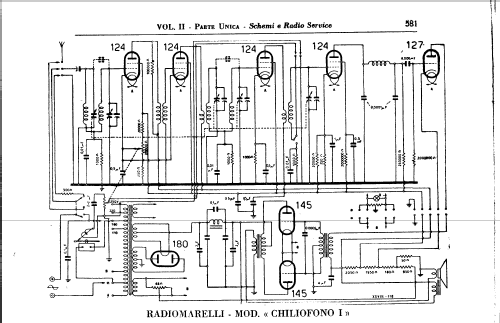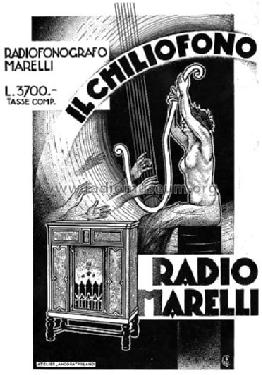Chiliofono I (1)
Marelli (Radiomarelli); Sesto San Giovanni (MI)
- Paese
- Italy
- Produttore / Marca
- Marelli (Radiomarelli); Sesto San Giovanni (MI)
- Anno
- 1931/1932
- Categoria
- Radio (o sintonizzatore del dopoguerra WW2)
- Radiomuseum.org ID
- 73916
Clicca sulla miniatura dello schema per richiederlo come documento gratuito.
- Numero di tubi
- 8
- Gamme d'onda
- Solo onde medie (OM).
- Particolarità
- Giradischi (non cambiadischi)
- Tensioni di funzionamento
- Alimentazione a corrente alternata (CA) / 110; 160; 220; 250 Volt
- Altoparlante
- AP elettrodinamico (bobina mobile e bobina di eccitazione/di campo)
- Materiali
- Mobile in legno
- Radiomuseum.org
- Modello: Chiliofono I - Marelli Radiomarelli; Sesto
- Forma
- Console, con gambe d'appoggio basse (< 50%).
- Dimensioni (LxAxP)
- 800 x 1100 x 445 mm / 31.5 x 43.3 x 17.5 inch
- Prezzo nel primo anno
- 3,700.00 ITL
- Fonte dei dati
- Guida Pratica Antique Radio II (2000)
- Bibliografia
- La moderna Supereterodina, Ravalico, 1938 (pag. 371)
- Letteratura / Schemi (1)
- -- Original prospect or advert
- Letteratura / Schemi (2)
- -- Schematic (La Riparazione degli Apparecchi Radio, Delforno - Colciago, Italy 1941)
- Autore
- Modello inviato da Alessandro De Poi. Utilizzare "Proponi modifica" per inviare ulteriori dati.
- Altri modelli
-
In questo link sono elencati 487 modelli, di cui 378 con immagini e 300 con schemi.
Elenco delle radio e altri apparecchi della Marelli (Radiomarelli); Sesto San Giovanni (MI)
Collezioni
Il modello Chiliofono I (1) fa parte delle collezioni dei seguenti membri.
Discussioni nel forum su questo modello: Marelli Radiomarelli: Chiliofono I
Argomenti: 1 | Articoli: 1
Dear all,
in the Forum thread ‘Old capacitor marking’ Prof. Dietmar illustrated several non-conventional volume control circuits used in the early age of the radio. This review recalled me the strange solution I found in the model ‘Chiliofono’, produced in Italy by Radiomarelli, in the very late twenties. This huge TRF receiver used a voltage divider, from the screen grid voltage (about 120VDC) to ground, to give a positive bias to the cathodes of the first two RF amplifier stages. The volume control is encircled in the diagram below. Considering the combined action of the cathode currents and of the current flowing from the power supply, the DC voltage on both cathodes roughly varied from 2V to 40V. The result was similar to the grid bias illustrated by Prof. Dietmar in the circuit of Fig. 172, the transconductance of the tubes decreasing when the positive cathode voltage was increased. The relatively high current passing in the volume control potentiometer asked for a wirewound type. By the way, the radio used a double section potentiometer, the second section wired as a variable attenuator on the phono pick-up.

in the Forum thread ‘Old capacitor marking’ Prof. Dietmar illustrated several non-conventional volume control circuits used in the early age of the radio. This review recalled me the strange solution I found in the model ‘Chiliofono’, produced in Italy by Radiomarelli, in the very late twenties. This huge TRF receiver used a voltage divider, from the screen grid voltage (about 120VDC) to ground, to give a positive bias to the cathodes of the first two RF amplifier stages. The volume control is encircled in the diagram below. Considering the combined action of the cathode currents and of the current flowing from the power supply, the DC voltage on both cathodes roughly varied from 2V to 40V. The result was similar to the grid bias illustrated by Prof. Dietmar in the circuit of Fig. 172, the transconductance of the tubes decreasing when the positive cathode voltage was increased. The relatively high current passing in the volume control potentiometer asked for a wirewound type. By the way, the radio used a double section potentiometer, the second section wired as a variable attenuator on the phono pick-up.

Emilio Ciardiello, 21.Nov.07






